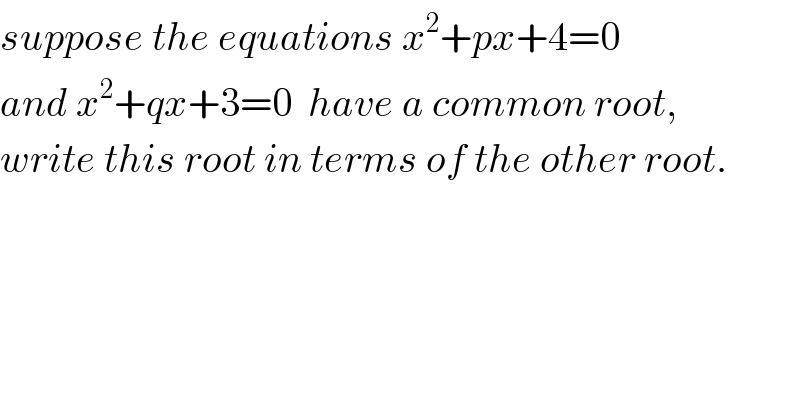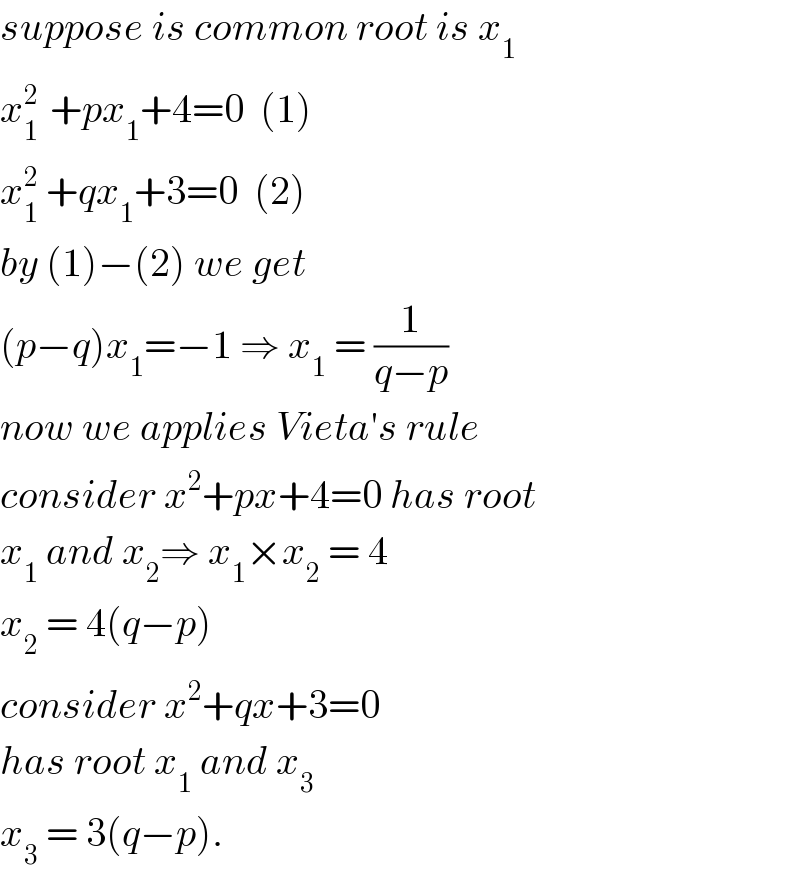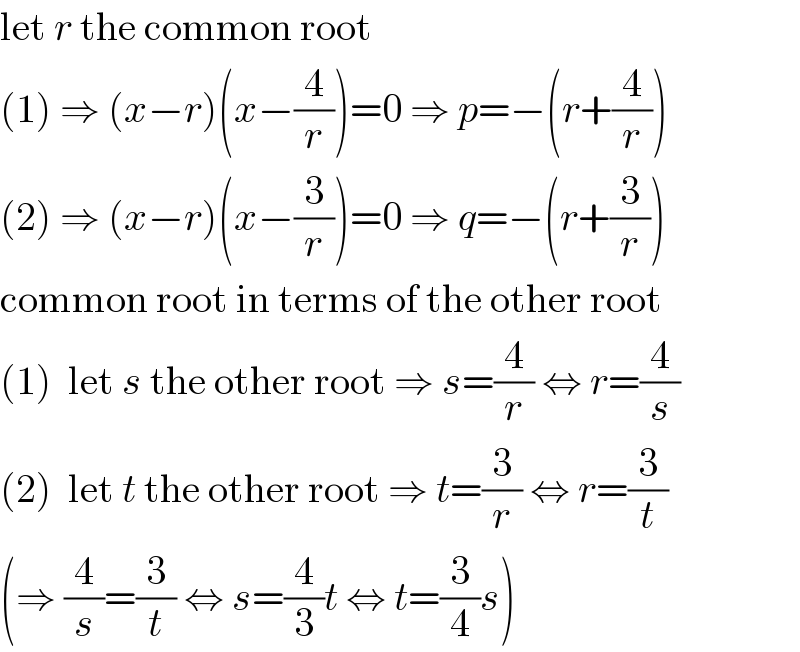Question Number 77119 by necxxx last updated on 03/Jan/20

$${suppose}\:{the}\:{equations}\:{x}^{\mathrm{2}} +{px}+\mathrm{4}=\mathrm{0} \\ $$$${and}\:{x}^{\mathrm{2}} +{qx}+\mathrm{3}=\mathrm{0}\:\:{have}\:{a}\:{common}\:{root}, \\ $$$${write}\:{this}\:{root}\:{in}\:{terms}\:{of}\:{the}\:{other}\:{root}. \\ $$
Answered by jagoll last updated on 03/Jan/20

$${suppose}\:{is}\:{common}\:{root}\:{is}\:{x}_{\mathrm{1}\:} \\ $$$${x}_{\mathrm{1}\:} ^{\mathrm{2}} \:+{px}_{\mathrm{1}} +\mathrm{4}=\mathrm{0}\:\:\left(\mathrm{1}\right) \\ $$$${x}_{\mathrm{1}} ^{\mathrm{2}} \:+{qx}_{\mathrm{1}} +\mathrm{3}=\mathrm{0}\:\:\left(\mathrm{2}\right) \\ $$$${by}\:\left(\mathrm{1}\right)−\left(\mathrm{2}\right)\:{we}\:{get}\: \\ $$$$\left({p}−{q}\right){x}_{\mathrm{1}} =−\mathrm{1}\:\Rightarrow\:{x}_{\mathrm{1}} \:=\:\frac{\mathrm{1}}{{q}−{p}} \\ $$$${now}\:{we}\:{applies}\:{Vieta}'{s}\:{rule}\: \\ $$$${consider}\:{x}^{\mathrm{2}} +{px}+\mathrm{4}=\mathrm{0}\:{has}\:{root}\: \\ $$$${x}_{\mathrm{1}} \:{and}\:{x}_{\mathrm{2}} \Rightarrow\:{x}_{\mathrm{1}} ×{x}_{\mathrm{2}} \:=\:\mathrm{4} \\ $$$${x}_{\mathrm{2}} \:=\:\mathrm{4}\left({q}−{p}\right) \\ $$$${consider}\:{x}^{\mathrm{2}} +{qx}+\mathrm{3}=\mathrm{0}\: \\ $$$${has}\:{root}\:{x}_{\mathrm{1}} \:{and}\:{x}_{\mathrm{3}} \: \\ $$$${x}_{\mathrm{3}} \:=\:\mathrm{3}\left({q}−{p}\right).\: \\ $$
Answered by MJS last updated on 04/Jan/20

$$\mathrm{let}\:{r}\:\mathrm{the}\:\mathrm{common}\:\mathrm{root} \\ $$$$\left(\mathrm{1}\right)\:\Rightarrow\:\left({x}−{r}\right)\left({x}−\frac{\mathrm{4}}{{r}}\right)=\mathrm{0}\:\Rightarrow\:{p}=−\left({r}+\frac{\mathrm{4}}{{r}}\right) \\ $$$$\left(\mathrm{2}\right)\:\Rightarrow\:\left({x}−{r}\right)\left({x}−\frac{\mathrm{3}}{{r}}\right)=\mathrm{0}\:\Rightarrow\:{q}=−\left({r}+\frac{\mathrm{3}}{{r}}\right) \\ $$$$\mathrm{common}\:\mathrm{root}\:\mathrm{in}\:\mathrm{terms}\:\mathrm{of}\:\mathrm{the}\:\mathrm{other}\:\mathrm{root} \\ $$$$\left(\mathrm{1}\right)\:\:\mathrm{let}\:{s}\:\mathrm{the}\:\mathrm{other}\:\mathrm{root}\:\Rightarrow\:{s}=\frac{\mathrm{4}}{{r}}\:\Leftrightarrow\:{r}=\frac{\mathrm{4}}{{s}} \\ $$$$\left(\mathrm{2}\right)\:\:\mathrm{let}\:{t}\:\mathrm{the}\:\mathrm{other}\:\mathrm{root}\:\Rightarrow\:{t}=\frac{\mathrm{3}}{{r}}\:\Leftrightarrow\:{r}=\frac{\mathrm{3}}{{t}} \\ $$$$\left(\Rightarrow\:\frac{\mathrm{4}}{{s}}=\frac{\mathrm{3}}{{t}}\:\Leftrightarrow\:{s}=\frac{\mathrm{4}}{\mathrm{3}}{t}\:\Leftrightarrow\:{t}=\frac{\mathrm{3}}{\mathrm{4}}{s}\right) \\ $$
